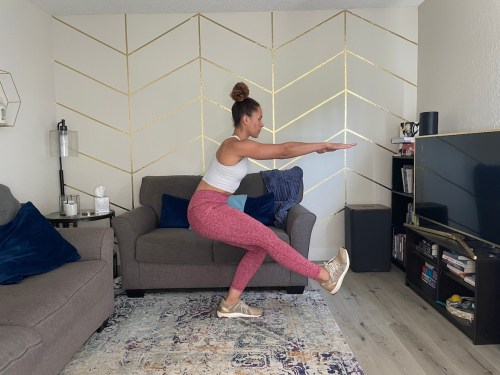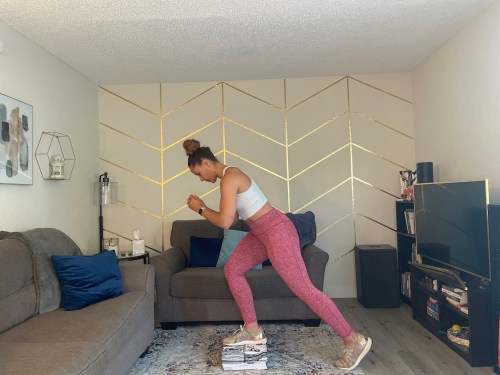The 8 Most Effective Exercises to Train All of Your Butt Muscles, According to Research
Learn how to do glute exercises that train all three butt muscle groups. Explore squats, lunges, hip thrusts, and more.

Strengthening your glutes is always a good idea. Among their many tasks: They stabilize your hips, propel you forward while walking or running, and help you balance when standing on one leg.
Experts in This Article
physical therapist at ATI Physical Therapy
trainer and creator of Chair Fit Camp
physical therapist at Sugarhouse Health Center
NASM-certified personal trainer
But there’s a lot of incorrect (or at least less than optimal) info out there when it comes to effective glute exercises. For example, fitness influencers doing lateral walks with booty bands and alleging they’re targeting the gluteus maximus. (They don’t.)
Before we go any further, let’s define what the glutes are: The gluteal muscles are made up of three distinct muscles on the outer and back of your hips. The gluteus minimum (or “glute min”) is the smallest of the bunch, and you can’t feel it since it lies deep behind the gluteus medius (or “glute med”).
Both the glute min and glute med (which is often targeted through upper glute workouts) function to stabilize the hip when you’re on one leg. For example, when you’re running there’s a significant demand on both of these two muscles, especially the gluteus medius, to stabilize the hip and not allow it to drop. Both muscles are also involved in moving the leg out to the side, away from your midline (hip abduction) and in rotating the leg in and out in the hip socket.
“These two smaller gluteal muscles are critical for everyday activities because of the role they play in hip stability. Weakness in them can lead to significant discomfort along the hip or changing mechanics all along the lower leg,” says physical therapist Jacqueline O’Neill, DPT, NCS. “Strengthening these muscles can be low-hanging fruit when it comes to improving movement.”
The largest muscle of the group, the glute max, is what’s most often associated with the glutes as it’s the larger, visual muscle that helps create the shape of our butt. It functions to extend the leg behind you and help rotate the thigh at the hip.
Why you want to train the glute muscles
In combination, all three of these glute muscles optimize the day-to-day movements of anyone who stands or walks.
“Functionally, we use glutes to support us when we carry heavy loads or run to catch the bus,” certified personal trainer Matthew Scarfo, CPT, previously told Well+Good about how our glutes help us function. “Your glutes act as a base to your spine, keeping your pelvis neutral, so that you have proper curvature in your lumbar, which helps you carry good posture all the way up your back and to your shoulders.”
But if you don’t use these muscles—say, you spend most of your days sitting stationary in front of a computer, in a car, and on the couch—they have a habit of “turning off” or growing weak, leading to what’s known as dead butt syndrome. That’s why we need to do dedicated glute exercises at home.
“If you think of a battery, if your glutes are supposed to be 100 percent charged, maybe now they’re only at 40 percent charge,” explains physical therapist Dallas Reynolds, DPT, COMT.
This typically happens when long stints of sitting stationary restrict blood flow, which keeps the muscles from firing properly. You might feel a tingling sensation, or like the muscles are “falling asleep.”
And it can have real consequences: Dead butt syndrome can make it harder for the muscles to contract and activate correctly, even when you do exercise, according to trainer Donovan Green, creator of Chair Fit Camp. Eventually, long-term weakness can lead to back pain and balance issues, and even something known as a Trendelenburg gait (where your hips drop from side to side with each step), Reynolds says.
Fortunately, squeezing some movement into your days whenever you can (even if it’s just 10 minutes of exercise), and targeting your weak glutes strategically with glute exercises at home, can help make sure they keep working the way you want them to.
What are the best glute exercises, according to science?
Even if you spend upward of eight hours a day on your tuchus, you aren’t doomed to a dead butt. Research has shown that some exercises are particularly effective at activating those glutes.
For starters, electromyography (EMG) studies on gluteus medius and gluteus minimus activation (like this one21) show that, generally speaking, single-leg exercises for glutes elicit the highest level of activation in the muscles. This makes sense, considering the role of the two smaller muscles in stabilizing the hip and leg during the single-leg phase of activity.
Meanwhile, EMG studies on the gluteus maximus (like this one) have shown that step-up exercises elicit the greatest demand on that muscle, followed by exercises like squats, deadlifts, and barbell hip thrusts. Interestingly, the barbell hip thrust had particularly high gluteus maximus activation, regardless of the specific form or weight used.
“In addition to overall activation, EMG studies also give key insight into how to progress the exercises—starting with lower activation and then moving into higher ranges as the individual is deemed ready for them,” O’Neal adds.
Which means, we can use this EMG research to develop a methodical approach and plan to strengthen the glute muscles.
“Functionally, we use glutes to support us when we carry heavy loads or run to catch the bus. Your glutes act as a base to your spine, keeping your pelvis neutral, so that you have proper curvature in your lumbar, which helps you carry good posture all the way up your back and to your shoulders.” —Matthew Scarfo, CPT
Your best glute workout plan
Ready to strengthen that backside? This plan is a progression, so you’re going to start with the first glute exercise and then only move on to the next once you can hit three sets of 10 reps without any difficulty. That’s the signal you’re ready to make your glute exercises tougher.
It’s important to space out the two groups of glute exercises during the week because, although each is targeted to specific gluteal muscles, there’s going to be some overlap with each of the exercises.
Ideally, you’d have at least 48 hours between each glute workout at home—for example, gluteus minimus and medius training on Tuesday and gluteus maximus training on Friday—so you aren’t overtraining or over-fatiguing those areas. (Remember: Your glutes work during your daily activities like walking and climbing stairs.)
Finally, we’ve included only bodyweight glute exercises up until the final level of each progression. The goal is to get up to that final stage, and then be able to go back to the beginning and progressively add weights.
Gluteus minimus and medius training
Level 1: Side-lying hip abduction

- 1.Lie on your left side with your legs extended and your feet stacked on top of each other.
- 2.Lean your head on your left arm to support your neck and place your right hand in front of you for support.
- 3.Keeping your legs straight and squeezing your glutes, lift your top leg to around shoulder height without letting your pelvis tilt.
- 4.Lower your top leg back down to starting position.
Level 2: Single-leg glute bridge

- 1.Lie on your back with your knees bent and feet hip-distance apart on the floor. Extend your arms down by your sides.
- 2.Lift your right leg off the ground, keeping your right knee bent at a 90-degree angle.
- 3.Press your left foot into the floor and squeeze your glutes. Keeping your right leg lifted, lift your hips as high as you can without arching your lower back.
- 4.Pause for a moment at the top of the movement, then lower your hips back down to the floor.
- 5.Repeat all reps on one side before switching to the other side.
Level 3: Running man

- 1.Stand tall with your feet hip-width apart and your arms down by your sides.
- 2.Bend your left knee slightly about 30 degrees.
- 3.Lift your right foot and slowly swing your right leg forward and backward like you’re running on that side, keeping your hips level.
- 4.As your right leg swings forward, swing your right arm up and your left arm back. As your right leg swings backward, swing your left arm up and your right arm back.
- 5.Repeat on opposite leg.
Level 4: Single-leg squat

- 1.Stand tall with your feet hip-width apart and your arms straight out in front of you.
- 2.Raise your right leg straight out in front of you.
- 3.Pressing into your left heel, bend your left knee and sit your hips back as if you were going to sit in a chair. Squat until your left thigh is parallel to the ground or as close to parallel as you can comfortably go.
- 4.Pause for a moment, then press into your left heel to straighten your left leg and return to standing.
- 5.Repeat all reps on one side before switching to the other side.
TIP
Hold onto something if you’re having trouble balancing, and only squat down as far as you’re comfortable. Your balance and depth will improve as you get better at the movement.
Gluteus maximus training
Level 1: Half squat

- 1.Stand tall with your feet hip-width apart and your arms clasped in front of your chest.
- 2.Bend your knees as you push your hips back to lower toward the floor about 45 degrees.
- 3.Pause for a moment, then press through your heels to straighten your knees and return to standing.
- 4.Repeat.
Level 2: Full squat

- 1.Stand tall with your feet hip-width apart and your arms clasped in front of your chest.
- 2.Bend your knees as you push your hips back to lower toward the floor like you were going to sit in a chair.
- 3.Lower down until your thighs are parallel to the floor (or as far as you can comfortably go).
- 4.Pause for a moment, then press through your heels to straighten your knees and return to standing.
- 5.Repeat.
Level 3: Lateral step-up

- 1.Stand tall with your arms down by your sides next to a box or step.
- 2.Step sideways with your nearest foot onto the step.
- 3.Press down through that sole to stand tall on the step, allowing the other foot to hover in the air.
- 4.Then reverse the motion to return back to the starting position with both feet on the ground.
- 5.Repeat all reps on one side before switching to the other side.
Level 4: Step-up

- 1.Stand tall with your arms down by your sides in front of a box or step.
- 2.Lift your right foot to step up onto the step.
- 3.Then lift your left foot to step up onto the step. You should be standing with both feet on top of the step.
- 4.Step back down with your left foot, then your right, to the starting position.
- 5.Repeat, alternating which foot you step with first.
Moore D, Pizzari T, McClelland J, Semciw AI. Rehabilitation Exercises for the Gluteus Medius Muscle Segments: An Electromyography Study. J Sport Rehabil. 2019 Nov 1;28(8):jsr.2018-0340. doi: 10.1123/jsr.2018-0340. PMID: 30747561.
↩︎Neto WK, Soares EG, Vieira TL, Aguiar R, Chola TA, Sampaio VL, Gama EF. Gluteus Maximus Activation during Common Strength and Hypertrophy Exercises: A Systematic Review. J Sports Sci Med. 2020 Feb 24;19(1):195-203. PMID: 32132843; PMCID: PMC7039033.
↩︎
Sign Up for Our Daily Newsletter
Get all the latest in wellness, trends, food, fitness, beauty, and more delivered right to your inbox.
Got it, you've been added to our email list.










